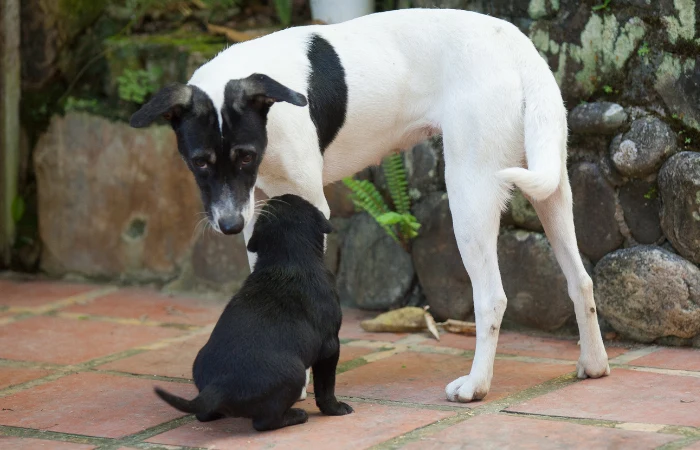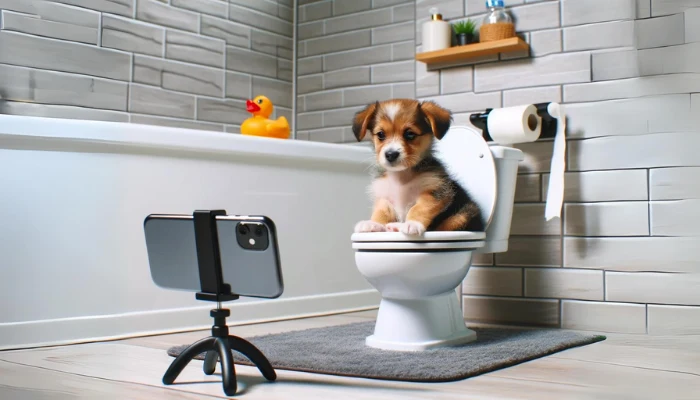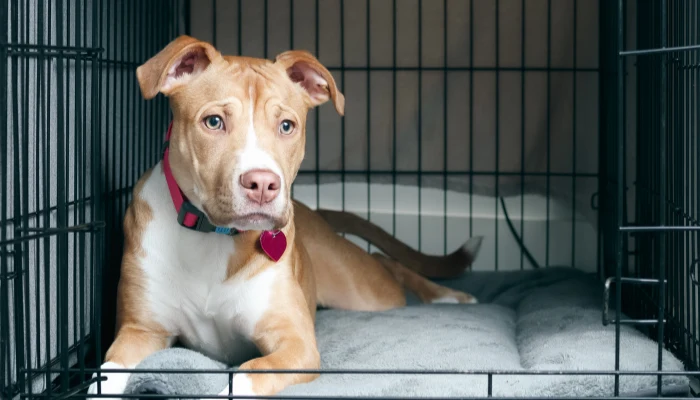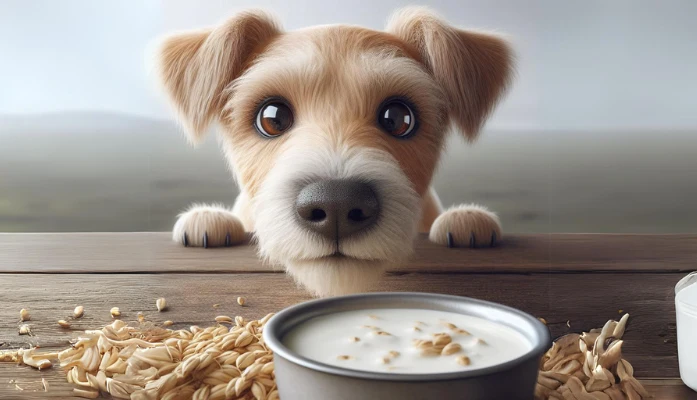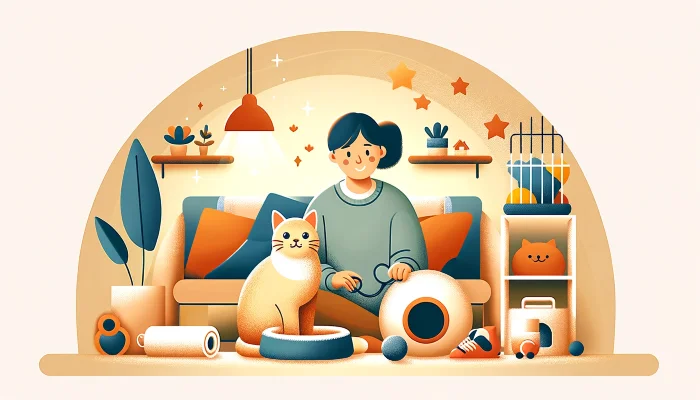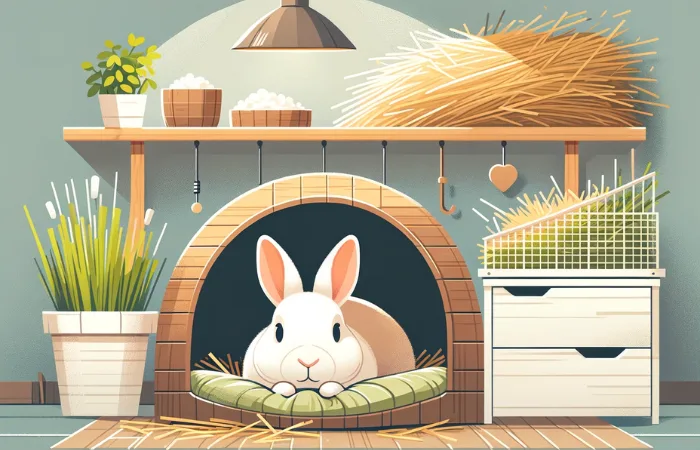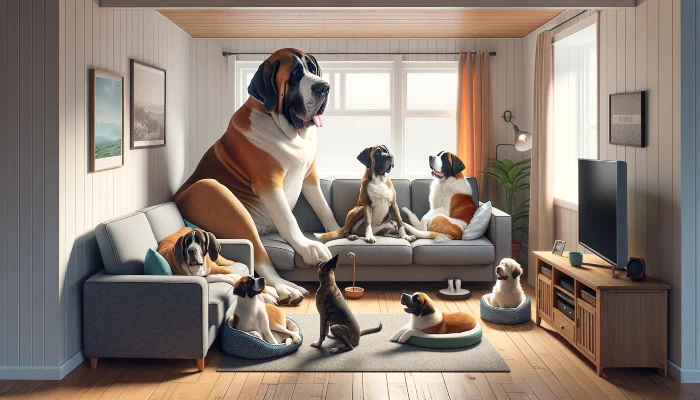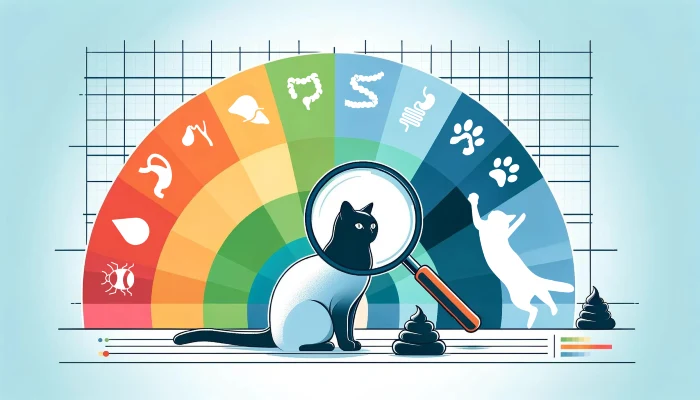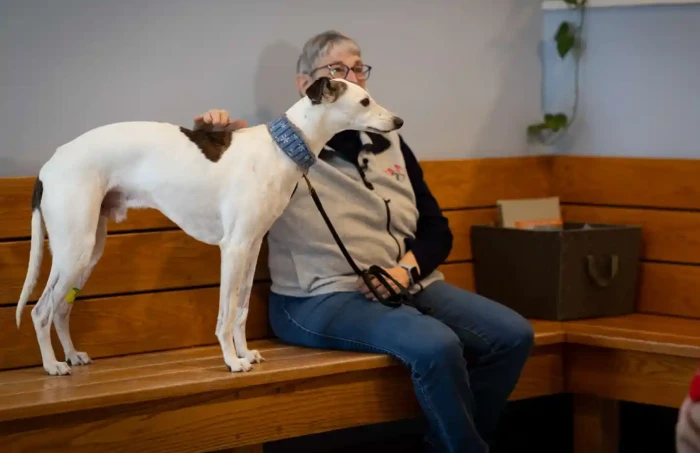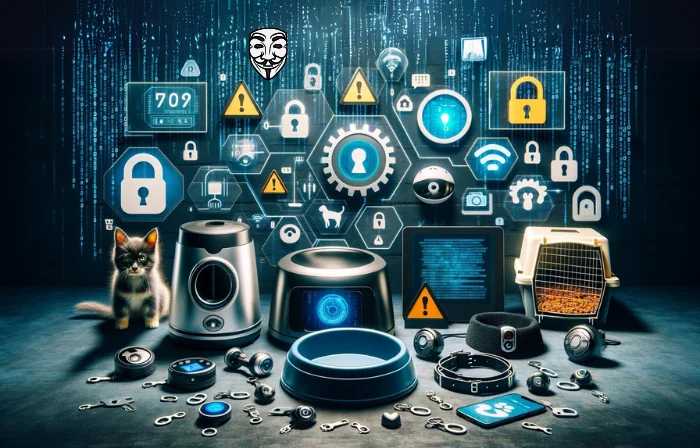Welcome to the journey of expanding your furry family! Bringing a “New Pup on the Block” is exhilarating, but introducing your new puppy to your older dog requires insight and patience. Dive into the Ultimate Guide, sprinkled with New Puppy with Older Dog Tips and Strategies for New Dog Introduction, guaranteeing a wagging success!
First Sniffs & Wags: Setting the Stage for Positive First Impressions!
Setting the stage right from the start is pivotal! First impressions count, even in the canine world.
Ensuring a peaceful and positive first meeting is fundamental in forging a friendly relationship between the new and existing pets. Dogs are territorial creatures. Introducing them in a neutral environment reduces the risk of the older dog feeling invaded, allowing both pets to interact without the added pressure of territorial defense. Additionally, leashing both dogs but allowing them slack provides a controlled environment where neither dog feels trapped.
This preliminary interaction should be short and sweet, rewarding both pets for good behavior to reinforce positive association. Each dog’s reaction to the other should be observed carefully, and the meeting should conclude on a positive note to set the tone for their future interactions.
Consider Lisa, a proud owner of Max, a five-year-old Golden Retriever. When she decided to bring Bella, a lively Labrador puppy, into the family, she chose a nearby park for their first meeting. With both dogs on leashes and enough space to explore, Max and Bella had the opportunity to acquaint themselves without feeling threatened in their personal spaces. With every cautious sniff and tentative wag, they started understanding each other, building the foundation for their future friendship under the open sky, amidst the neutral and stress-free environment of the park.
Key Points:
- Neutral Territory: Initiate the first meeting in a neutral, non-threatening environment. This approach avoids territorial aggression, easing the introduction process.
- Controlled Leash Introduction: Maintain both dogs on leashes, allowing them to observe and sniff each other without overwhelming contact. Observe their body language closely, intervening if signs of stress or aggression appear.
- Positive Reinforcement: Reward both dogs for calm and accepting behavior with treats and praise, reinforcing the positive experience associated with meeting each other.
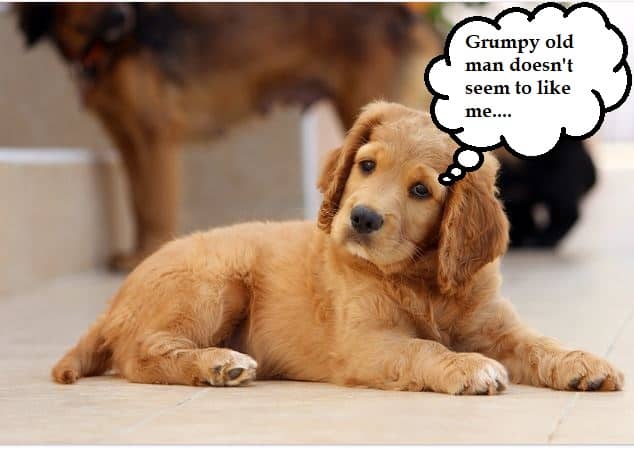
Creating a Pup-Safe Haven: Preparing Your Home for the New Arrival!
Before the new pup prances into your dwelling, certain preparations ensure a seamless transition.
Proactive preparation of your home is vital before introducing a new puppy. Each dog should have a safe and comfortable space where they can retreat and relax. In the early days, these separate spaces prevent conflicts during feeding or playing, allowing each dog to have a sense of ownership and control over their environment.
Remove items that may cause possessiveness or aggression from the older dog. These can include favorite toys, bones, or beds. Once the dogs are more comfortable and familiar with each other, these items can be gradually reintroduced.
Puppy-proofing is another significant step in creating a safe environment. Much like toddlers, puppies are curious and will explore their surroundings, often leading to them chewing or swallowing non-edible items. Remove small objects that can be swallowed, secure trash cans, and keep electrical cords out of reach.
John, already a pet parent to a grumpy but lovable Beagle named Buster, decided to adopt Daisy, a spirited and curious Beagle puppy. Aware of Buster’s occasional possessiveness, John took precautions. He designated separate, cozy spaces for both dogs, removed Buster’s favorite chew toys temporarily, and puppy-proofed his home, removing any items Daisy could chew or swallow. This preparation eased Daisy’s entry into the household, reducing potential friction points and providing both dogs with a sense of security and comfort.
Key Points:
- Safe Space for Each: Designate safe, comfortable spaces for both dogs. These areas offer refuge during stressful moments, providing security and personal space.
- Remove Trigger Items: Temporarily eliminate high-value items like favorite toys or bones that might instigate possessiveness or conflict between the dogs.
- Secure Environment: Puppy-proof the house similarly to baby-proofing, removing hazardous items, and creating a safe, engaging environment for the new arrival.
The Dynamic of the Pack: Understanding Older Dog’s Feelings!
Understanding the sentiments of your older dog is crucial as you bring a new furry member into your home. Dogs have their own unique ways of expressing feelings, and recognizing these signs can significantly ease the integration process.
Your older dog might feel anxious, excited, or even jealous. It’s essential to spend quality time with the older dog, offering extra attention and affection to assure them that their place in the pack isn’t threatened. Maintain their routine as much as possible to provide a sense of normalcy and security.
It’s also vital to observe and respect the older dog’s reactions to the new puppy. If they seem overwhelmed or stressed, it’s wise to give them some space and gradually increase the time they spend together as they become more comfortable.
When Sarah brought home a playful Dachshund puppy, she noticed her older Border Collie, Jake, exhibiting signs of stress. She made sure to give Jake extra cuddles and kept their daily walk schedule unchanged. Over time, Jake’s stress diminished, and he started accepting and even playing with the new puppy, forming a delightful and heartwarming bond.
Key Points:
- Quality Time: Offer extra attention and love to your older dog.
- Maintain Routine: Keep the older dog’s routine unchanged to provide stability.
- Respect Reactions: Observe and respect your older dog’s reactions, adjusting their interaction with the new puppy accordingly.
Baby Steps: Gradual & Positive New Puppy with Older Dog Tips!
Taking baby steps is the mantra when integrating a new puppy with an older dog. It’s a dance of careful planning and execution, fostering a positive relationship between both dogs.
Introduce them gradually in various settings, monitoring their interactions and stepping in when necessary. Allowing them to observe each other from a distance initially, and then gradually decreasing this distance as they become more comfortable, is crucial.
In addition, engage in activities that both dogs can enjoy together, like walking or playing fetch, promoting positive associations and shared experiences. This shared time helps to strengthen their bond, fostering feelings of companionship and mutual respect.
Alex, upon adopting a spirited Terrier named Milo, ensured that the introduction to his older dog, a gentle Labrador named Rex, was gradual. He first allowed them to observe each other from a distance. Over the following weeks, they started sharing short, supervised play sessions, eventually enjoying long walks together, cementing their budding friendship.
Key Points:
- Gradual Introduction: Slowly introduce the new puppy to the older dog in various settings.
- Monitor Interactions: Supervise their early interactions and intervene when necessary.
- Shared Activities: Engage in activities that both dogs can enjoy together to foster a positive relationship.
The Power of Scent: Strategies for New Dog Introduction Using Smells!
In the canine world, scent is a powerful communication tool, providing heaps of information about each other. Recognizing the importance of scent in introductions can be your ace in the hole in facilitating a smooth transition for both dogs.
Start by exchanging the bedding of both dogs before the introduction. This tactic allows both dogs to get familiar with each other’s scents, fostering a sense of familiarity. When they eventually meet, the smell won’t be entirely foreign, helping reduce potential anxiety or aggression.
In addition, avoid bathing both dogs right before the introduction so as not to mask their natural scents. Allow them to explore and smell each other without interruption, as this is a crucial part of their greeting and getting-to-know process.
When Olivia decided to introduce her senior Shih Tzu, Daisy, to her newly adopted Poodle, Max, she diligently exchanged their bedding a few days prior. Daisy got acclimated to Max’s scent and was more at ease when they finally met, making the initial interaction smoother and more positive.
Key Points:
- Scent Familiarization: Exchange bedding to familiarize both dogs with each other’s scents.
- Avoid Bathing: Don’t mask their natural scents; let them smell each other without interruption.
- Allow Exploration: Permit both dogs to explore and sniff each other, facilitating a natural introduction process.
Playtime Protocol: Navigating Safe and Happy Play Between New and Older Dogs!
Establishing rules and monitoring playtime between the new and older dog is essential in nurturing a happy and respectful relationship between them.
Creating a controlled environment where both dogs can engage in play is crucial. Intervene if the play gets too rough or if one dog seems to be overwhelmed. You also need to understand each dog’s play style and tolerance levels, adjusting the environment and playtime duration accordingly.
Giving both dogs equal attention and praise during playtime fosters a positive atmosphere, reducing jealousy or competition for your affection. Encourage and reward good behavior consistently to instill good habits and a strong sense of companionship between your pets.
Michael observed that his older German Shepherd, Rocky, enjoyed a more laid-back play style, while his new Siberian Husky puppy, Luna, was energetic and boisterous. He closely supervised their play sessions, ensuring that Luna’s enthusiasm didn’t overwhelm Rocky, and gradually, they learned to adjust their play styles to accommodate each other.
Key Points:
- Controlled Environment: Create a safe and controlled space for both dogs to play.
- Understand Play Styles: Recognize and respect each dog’s play style and tolerance levels.
- Equal Attention: Provide both dogs with equal attention and praise during playtime to foster a positive relationship.
Feeding Frenzy: Establishing Peaceful Meal Times with Multiple Dogs!
Meal times can be a source of tension when introducing a new dog, as dogs can be possessive about their food. Hence, establishing protocols for peaceful meals is imperative.
Initially, consider feeding the dogs in separate spaces to avoid any potential resource guarding.
As they grow more comfortable with each other, you can gradually feed them in the same room, but still maintain separate bowls and some distance.
Always supervise mealtimes to prevent any scuffles and step in if needed.
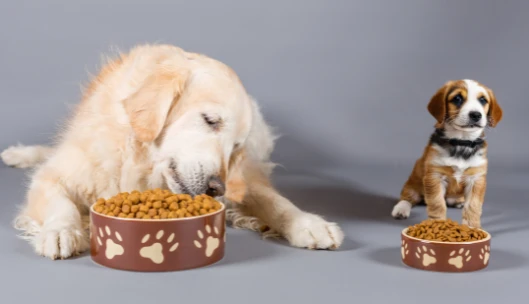
It’s crucial to understand and respect each dog’s eating habits and pace. Never force them to share bowls or eat closer than they’re comfortable with, allowing them to enjoy their meals stress-free.
Tina, who recently adopted a feisty Corgi named Bella, noticed that her older dog, a placid Greyhound named Ace, was uncomfortable eating close to Bella. Tina decided to feed them in different rooms initially. Over time, as Bella and Ace became accustomed to each other, Tina could feed them in the same area, respecting their individual spaces and eating habits.
Key Points:
- Separate Spaces: Initially, feed the dogs in separate spaces to prevent resource guarding.
- Supervised Mealtimes: Always watch over them during meals to step in if necessary.
- Respect Eating Habits: Understand and respect each dog’s eating pace and habits, never forcing them to share or eat closely.
Training Triumphs: Encouraging Good Behavior in Both Pups!
Training is a cornerstone in establishing a harmonious multi-dog household. Consistency in enforcing rules and commands for both dogs is crucial, as it sets the expectations for behavior in the home.
Refrain from showing favoritism during training sessions, treating both dogs equally. If one dog is more trained than the other, use this as an opportunity for the less experienced dog to learn by observing the trained dog’s behavior.
Implement positive reinforcement techniques, rewarding both dogs for good behavior and compliance with commands. This approach fosters a learning environment where the dogs understand what is expected and are motivated to comply.
When Sam introduced a Labrador puppy, Oliver, to his well-trained Boxer, Max, he used consistent commands for both. Oliver quickly picked up on the commands as he observed Max responding to them. Sam rewarded both dogs with treats and praise for compliance, creating a positive and structured learning environment.
Key Points:
- Consistent Commands: Use consistent rules and commands for both dogs to set behavioral expectations.
- Equal Treatment: Avoid favoritism and treat both dogs equally during training.
- Positive Reinforcement: Reward good behavior in both dogs to encourage compliance and learning.
Health Check: Ensuring Both Dogs are Healthy for Happy Coexistence!
A vital aspect often overlooked is the health of both your dogs. A healthy environment ensures a happy and stress-free coexistence between your new and older pets. Before you even bring the new pup home, make sure both animals are in optimal health.
Both dogs should be up-to-date on vaccinations, deworming, and flea and tick preventatives to prevent the spread of diseases.
If one of the dogs is sick, delay the introduction until they’re fully recovered to avoid unnecessary stress and potential transmission of illness.
Monitoring the health and well-being of both dogs continuously is crucial, as a healthy pet is typically a happy and well-adjusted one. Keeping them healthy ensures that they can interact and bond without any additional stress or issues.
When Emma brought a new Bulldog puppy, Duke, into her home, she made sure her older Retriever, Molly, and Duke had recent vet check-ups and vaccinations. Ensuring both pets were healthy, facilitated a smoother and safer introduction, allowing them to start their relationship on a positive and healthy note.
Key Points:
- Up-to-Date Healthcare: Ensure both dogs are vaccinated, dewormed, and protected against parasites.
- Monitor Health: Consistently check the health of both dogs, delaying introduction if one is unwell.
- Continuous Care: Regular vet visits and attention to their well-being are crucial for both pets’ happy living.
Building a Lifelong Bond: Nurturing a Strong Connection Between Your New and Old Pooch!
Creating a bond that lasts a lifetime between your new puppy and older dog is a rewarding experience that requires patience and understanding. Positive reinforcement, shared experiences, and time spent together are the building blocks of a strong and enduring connection.
Foster situations where both dogs can have positive and enjoyable interactions. Regular walks, play sessions, and quiet time together can help build familiarity and affection between the two. Observing their comfort levels and gradually increasing their shared activities can foster a deep and understanding bond.
Celebrate small milestones and successes in their relationship. Positive reinforcement for their good behavior towards each other can encourage a respectful and loving bond, laying the foundation for a lifetime of companionship and shared adventures.
Carlos was keen on building a strong bond between his older Dalmatian, Spot, and the new Shih Tzu pup, Coco. He organized joint play sessions and walks, always reinforcing positive interactions with treats and praise. Over time, Spot and Coco developed a deep connection, with Spot even becoming protective and caring towards little Coco.
Key Points:
- Shared Positive Experiences: Engage both dogs in enjoyable and positive activities together.
- Celebrate Milestones: Acknowledge and reward small successes in building their relationship.
- Time and Patience: Allow the bond to develop naturally over time, fostering a deep and lasting connection.
Conclusion: Embarking on a Joyful Journey of Canine Companionship!
Congratulations! You’ve successfully navigated through the delightful yet intricate dance of introducing a new puppy to your older dog. This adventure, sprinkled with challenges and triumphs, is a pathway leading to a household brimming with laughter, barks, and wagging tails.
The journey might seem daunting initially, but with a thoughtful approach, understanding, and patience, it can indeed be smooth and rewarding. Each step you’ve taken, from the initial sniff to shared mealtimes and play sessions, contributes to building a harmonious canine relationship under your roof.
More To Discover
Before you go, let’s revisit the crucial takeaways from this guide:
- Set the stage for a positive first impression in a neutral environment.
- Prepare your home to be a haven for both your new and old furry friends.
- Understand and respect the dynamic of the pack and the feelings of your older dog.
- Take baby steps for a gradual and positive introduction.
- Recognize the power of scent in easing the introduction process.
- Establish safe and happy play protocols to nurture their budding relationship.
- Ensure peaceful mealtimes to avoid tension and conflicts during feeding.
- Train and encourage good behavior in both dogs for a well-disciplined duo.
- Maintain a regular health check routine for the well-being of both pets.
- Invest time and love in building a lifelong bond, celebrating every small milestone in their relationship.
By meticulously following these steps, you’re not just introducing a new pet; you’re weaving a tapestry of memories and experiences that both your dogs will cherish. So, here’s to a home echoing with joyful barks, a yard imprinted with playful paws, and a heart swelling with love for your delightful, furry companions! 🐾 🏡 🐶








